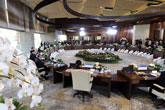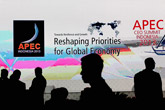APEC Summit: Are we likely to see a clash between China and the US?

Drawing by Alexey Iorsh
China has already hosted the Asia-Pacific Economic Cooperation (APEC) Summit once. When Shanghia hosted the 2001 summit, both China and APEC were facing other challenges. Choosing Shanghai as the venue was dictated by the need to give a boost to the more advanced southern Chinese provinces and cities by attracting Western investment and technology. Moreover, at the time there was no American-inspired Trojan horse: The proposed Trans-Pacific Partnership (TPP) agreement began in 2005 as the Trans-Pacific Strategic Partnership Agreement.
In July 2013, Malaysia hosted the 18th round of talks on a Free Trade Area within the TPP. Japan was also invited to participate in the negotiations, while China and Russia have not yet received official invitations.
It's evident that this project is aimed at torpedoing two ships at the same time: APEC and China's regional interests. Sinking the APEC ship would give the Americans a chance to shove China out to the periphery of regional integration. The latter would be unfavourable for Russia, although Moscow's economic presence in the region is not comparable with that of Beijing.
The major issue here is the possible regional clash of interests between the US and China. Currently, Beijing is on a par with Washington in terms of regional integration. On January 1, 2011 it launched the ASEAN + 1 (China) project, which has been operating successfully since. China also takes active part in ASEAN + 6 (the six being: China, Japan, South Korea, India, Australia and New Zealand). In other words, given the strength of Chinese economy, one can say that there is a rapid shaping of some kind of Chinese core within APEC.
Having realized that it was too late to follow the Chinese model, the Americans opted for a different strategy. Within the TTP they are trying to advance the cooperation issues that didn't find support in APEC. The American project majorly involves the development of export credit for promoting food exports to developing countries. Experts believe that the country to benefit would be primarily the United States.
Chinese fingerprints in Bali
During the last summit in Indonesia in 2013, a clash between China and America did not happen. Was this because of the absence of US President Barack Obama, who failed to arrive to Bali (just as he did to Vladivostok in 2012). Or, as they say, the time of great struggle has not yet come. Either way, the summit was held under the informal influence of China and Indonesia. The summit's final declaration ‘Sustainable APEC - The engine of global growth’ and other documents reflected the traditional trend: the convergence of economies within APEC's usual standards of regional integration. At that, the documents and statements clearly showed “Chinese fingerprints”
President Xi Jinping has initiated a number of projects focused on the development of transport and communication infrastructure in the region, including the idea of creating the Asian Infrastructure Investment Bank and others. Naturally, the Americans reacted to this, announcing the possibility of establishing the fund for development of transport logistics in the Asia-Pacific region. The matter concerned improving the efficiency of airports, customs, marine terminals and other structures.
Related:

Asia-Pacific free trade deal high on agenda at APEC meetings
Putin to visit China November 9-11 to attend APEC summit
Putin, Obama may meet on sidelines of APEC summit — Kremlin
Books about Vladimir Putin increasingly popular in China ahead of APEC summit
Russia simultaneously a member of APEC and of the Customs Union
Russia looks to promote the idea of efficient use of energy (hydrocarbons, electricity and nuclear energy) at the APEC summits. Then there is a concept (presented in Vladivostok) of integration and development of Siberia and the Far East, involving the use of resources of the leading Asian economies. It was all briefly formulated in the report of President Vladimir Putin in Indonesia titled ‘New sources of sustainable and long-term economic growth in the Asia-Pacific Region’)
What sets apart Russia's current position in APEC is its desire to adapt the integration processes in the Asia Pacific region to the projects of the forming Eurasian Economic Union and the Customs Union (CU). That said, today neither Moscow, nor Astana, nor Minsk are expecting a clear answer. The key topic is different: it's the desire of Russia and its partners to ‘stake out’ in the future and for good the possibility of combining the integration of Eurasian and Pacific projects. It may be, for instance, the APEC + Eurasian Union option or something else.
In this case, Russia begins to play a key role in the both setups. The upcoming Beijing Summit may become an important milestone when China, the US and others look at the issue in a different perspective. Vietnam and several other APEC countries in Vladivostok (2012) expressed their desire to create a Free Trade Area (FTA) with Russia.
Dr Sergey Luzyanin is the Deputy Director of the Institute of Far Eastern Studies of the Russian Academy of Sciences
All rights reserved by Rossiyskaya Gazeta.
Subscribe
to our newsletter!
Get the week's best stories straight to your inbox
